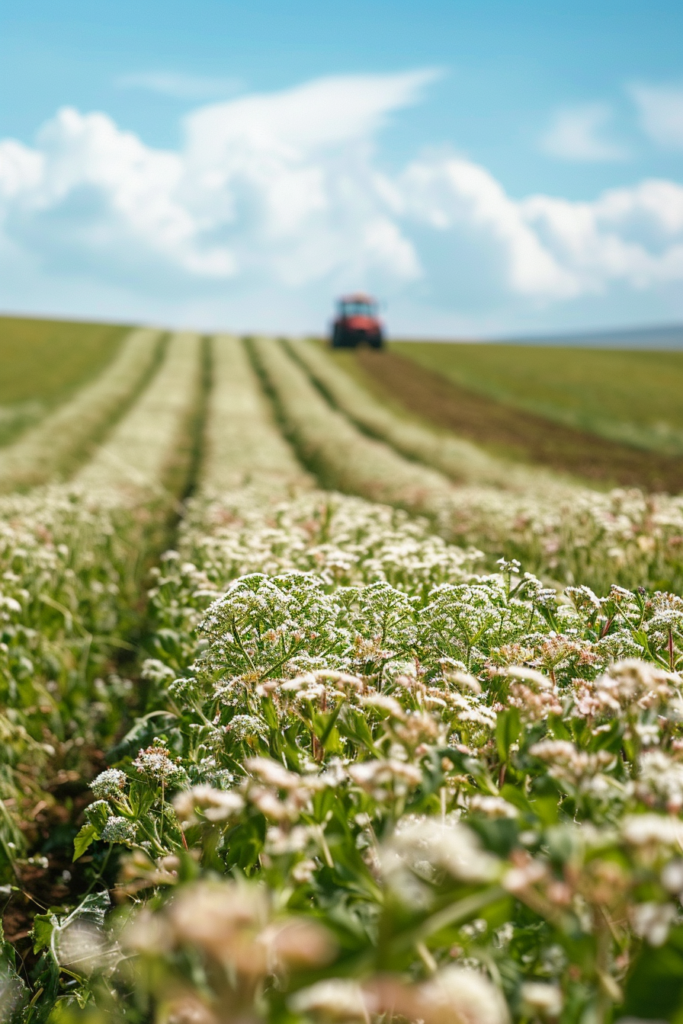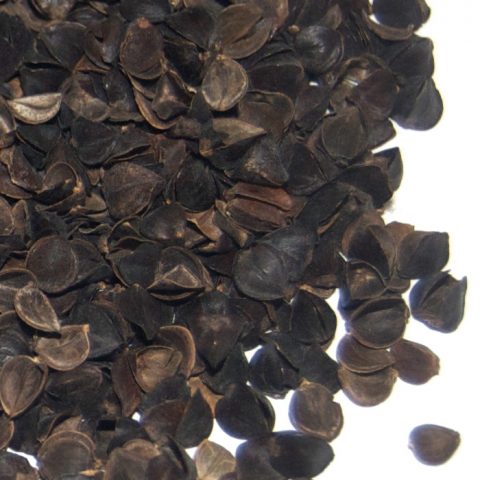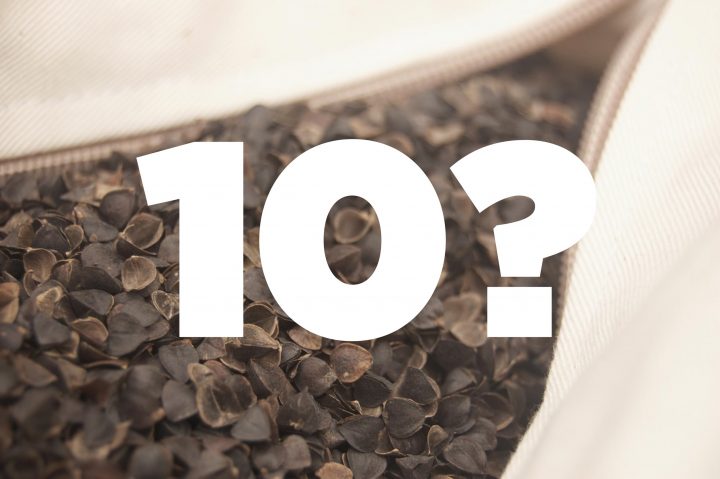
Buckwheat pillows can last a long time with a little maintenance.
Buckwheat pillows are usually a little more expensive than other popular pillow types, so it’s reasonable to ask, “how long do buckwheat pillows last?” After all, the longer it’s around, the more cost effective your purchase will be.
My first buckwheat hull pillow’s manufacturer claimed it would last 10 years or more.
Being a buckwheat pillow newbie, I was a little skeptical when I placed my order. I wasn’t so sure it’d work out, so I purchased one of the cheapest available. It turned out to be great!
Unfortunately, it ripped open and dumped its hulls all over my bed after a few years of loyal service. Despite the hull explosion, I really wasn’t too disappointed. It was the best pillow I’d ever owned.
Lesson learned. High-quality materials and construction matter!
My first buckwheat pillow didn’t last forever because the seams split. The construction and materials used went largely unnoticed until it failed, but it was now obvious that it wasn’t very well made. Buckwheat hulls are pretty hefty, so the case containing it needs to be tough. A standard size (20×26″) buckwheat pillow can weigh between 7 and 10 lbs. It is very important that the pillow be constructed from durable materials including:
- a medium weight breathable cotton fabric that will stand up to continued use and washing.
- a zipper that will not break or separate.
- an extra-strong thread that won’t snap under pressure.
A well-made case with a zipper will last indefinitely, but…
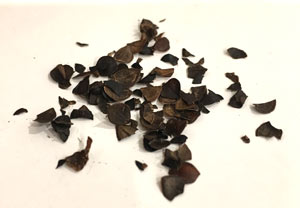
These buckwheat hulls have become crushed with prolonged use. They aren’t quite as awesome as they used to be!
A buckwheat hull pillow’s filling doesn’t last forever.
Buckwheat hulls do slowly break down and flatten out over time depending on use and humidity. It generally is a matter of years before you’ll notice any substantial degradation, but flattened or crushed buckwheat hulls can cause a couple (small) problems:
- The buckwheat hulls will lose some of their volume. Your pillow may feel flatter and not provide the support it once did.
- The crushed buckwheat hulls will not be as malleable as they once were. They will not grip one another like intact hulls do. As a result, your pillow won’t hold its shape as well as it could.
- There’s less space between the buckwheat hulls when they’ve been crushed flat. Consequently, the benefit of air circulation (and a cool pillow) is diminished.
Fortunately it’s easy to replace buckwheat hulls.
If you feel like your pillow would be better with new buckwheat hulls, just dump the old ones out (they make terrific mulch) and replace them with new pillow-grade buckwheat hulls. Good as new 🙂
“But my depression-era buckwheat pillow from Grandma is still awesome,” you say. That’s totally reasonable. The degradation of the filling isn’t very obvious. It happens slowly and subtly over time. A ten year old buckwheat pillow with crushed buckwheat hulls can feel awesome compared to the soft squishy pillows you used to sleep on, but it isn’t going to be quite as effective as it once was.
Keep your pillow clean and it’ll last longer!
Nobody likes to sleep on a dirty, sweat-stained pillow. It should go without saying: keep your pillow clean. Smells and appearances aside, the oils, dirt and organic matter that can build up on any pillow’s fabric case will shorten its lifespan. Keep your pillow inside a traditional sham or pillowcase and wash it periodically. This will protect your pillow, keeping it safe from stains and abrasive surfaces.
Eventually the fabric case containing the buckwheat hulls will need a wash too. When you’ve determined it’s time, remove the buckwheat hulls and toss the fabric case into the washing machine. Check out this step-by-step guide to washing your buckwheat pillow.
How long do buckwheat hull pillows last? (really)
I think that saying buckwheat pillows last 10 years is a bit of an overstatement because most of the products I’ve seen aren’t tough enough to hold up. Subpar construction and materials won’t last under the weight of buckwheat hulls.
Additionally, a discerning and observant buckwheat pillow user (a sleep nerd like myself) will notice the difference between a new buckwheat pillow and one that’s rolled around on a bed for ten years. They’ll feel that the buckwheat hull filling, after prolonged use, has become less effective at supporting their head and neck.
Now, I’ll take a ten year old buckwheat pillow over a traditional squishy pillow any day. For me, it’s always going to be superior to the alternatives. With just a little maintenance, however, it can be as exceptional as it was new. A buckwheat pillow will last a REALLY long time provided:
- the fabric case containing the buckwheat hulls is durable,
- the fabric edges are surged and seams are double-stitched,
- you keep it clean
- and replace the buckwheat hulls when needed.
It’s safe to say that you can expect a well-made buckwheat pillow to last significantly longer than most traditional pillows. Your milage will vary depending on use, care and maintenance.
Designed for comfort, made to last.
If you’ve decided a buckwheat pillow is worth giving a shot, please consider our product, Hullo™. We think it’s the best buckwheat pillow available, but don’t take our word for it, check out these customer reviews.
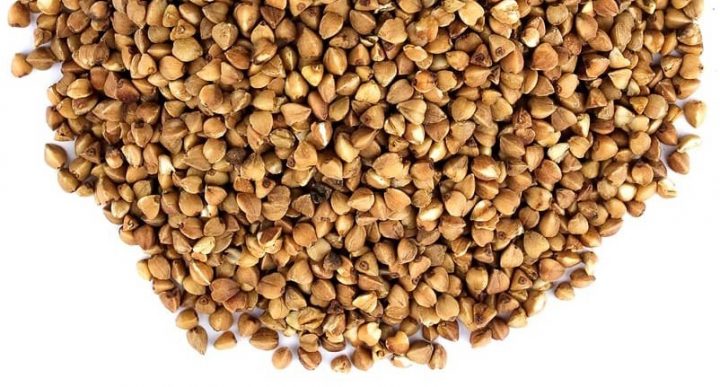 One of the most common questions from our customers is, “What is buckwheat?”
One of the most common questions from our customers is, “What is buckwheat?”
Buckwheat, or Fagopyrum tataricum, is a hearty plant bearing three sided grain-like seeds. At maturity it stands at between 2 and 4 feet tall. It flowers prolifically for two to three weeks. Then it produces hundreds of small brown seeds with high nutritional value. Each seed, or groat, is protected by a hard outer shell or hull much like a sunflower seed.
The buckwheat plant is one of the world’s first domesticated crops.
It’s thought that cultivation began in Southeast Asia around 5 or 6 thousand years ago. From there it spread to Central Asia, the Middle East, and then Europe. Buckwheat use was documented in Finland by at least 5300 BCE. It was finally brought to North America in the 1600s.

Buckwheat was a much more popular crop before the introduction of nitrogen fertilizers in the 20th century.
The industrial revolution delivered impressive new technologies to farms around the world. Notably, new fertilizers dramatically increased the productivity and profitability of other popular staples like wheat and maize. This advancement resulted in substantially reduced buckwheat production. As a result, in America, over a million acres of buckwheat were harvested in 1918. By 1954 production decreased to just 150, 000 acres.
It used to be that most of the buckwheat produced was used for livestock and poultry. However, today most buckwheat production is for human consumption. During the mid 1970s demand for new breakfast cereals and buckwheat noodles skyrocketed. This caused a surge in interest in buckwheat as food.
Building on this recent popularity, the marketing of “ancient grains” as healthy alternatives to traditional modern foods has made buckwheat a resurgent crop.
Russia, China and Kazakhstan are currently the world’s largest producers of buckwheat.
America is the 4th largest producer. In recent years America harvests about 75,000 acres annually. Most buckwheat grown in the USA comes from New York, Pennsylvania and North Dakota.
The majority of U.S. produced buckwheat is for the Japanese market. They love their soba noodles! For this reason, in 2013 Japan accounted for 96% of buckwheat exported from America!
Boekweit not wheat
Buckwheat’s name derives from the seed’s appearance, which resembles a seed of the beech tree. We can thank the Dutch for this insight: “boekweit,” means beech-wheat. Despite its name, buckwheat is not a type of wheat at all. It is actually part of the rhubarb family and is considered a fruit.
Buckwheat grows best in a cool moist climate, and can thrive in subpar earth. As a result, farmers like it because it’s easy and economical to produce. It requires little to no fertilizer or pesticides. It also requires minimal maintenance. Buckwheat grows very quickly, maturing in just 30 days. While in most respects, it’s easy to grow, buckwheat is sensitive to unfavorable weather conditions. It is killed quickly by frost and higher temperatures can prevent seed formation. Buckwheat can be susceptible to to drought as well due to its relatively short root system.
What is it used for?
Food (Soba Noodles, Kasha and Pancakes!)
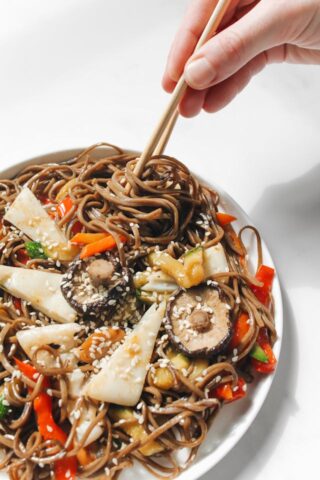
Buckwheat has long been utilized as a source of nutrition. Specifically, it contains a well balanced mix of starch, fat, protein and minerals. According to the USDA:
In a 100 gram serving, buckwheat provides 385 calories and is a rich source (20% or more of the Daily Value, DV) of protein, dietary fiber, four B vitamins and several dietary minerals, with content especially high (47 to 65% DV) in niacin, magnesium, manganese and phosphorus. Buckwheat is 72% carbohydrates, including 10% dietary fiber, 3% fat and 13% protein (table).
Source: USDA
It is naturally gluten-free, making it an excellent choice for those with celiac disease or gluten sensitivity. Rich in dietary fiber, buckwheat supports digestive health by promoting regular bowel movements and preventing constipation. Its high levels of antioxidants, such as rutin, quercetin, and phenolic acids, help combat oxidative stress and reduce inflammation in the body. Buckwheat is also a good source of plant-based protein, providing all essential amino acids, which are crucial for muscle repair and growth. Additionally, it contains important minerals like magnesium, manganese, and copper, which contribute to bone health, energy production, and immune function. Regular consumption of buckwheat can aid in managing blood sugar levels and improving cardiovascular health due to its low glycemic index and cholesterol-lowering properties.
Global Demand for Buckwheat: From Japanese Soba Noodles to Eastern European Kasha
Japan imports 100,000 metric tons of buckwheat annually. Most of this imported buckwheat is used specifically to produce soba, a popular type of thin noodle. Soba is a staple in Japanese cuisine and is enjoyed in various forms. It can be served chilled with a dipping sauce, known as “zaru soba,” or as a hot soup, “kake soba,” often garnished with green onions, tempura, or other ingredients. The versatility and nutritional benefits of buckwheat make it a valuable food source not only in Japan but around the world.
Food products sold in American markets are primarily processed flours, pancake mixes or breakfast cereals. In contrast, Eastern Europeans prefer their buckwheat boiled in water or milk, calling it kasha.
Buckwheat groats are a light brown color when fresh and removed from their hulls. The groats must be used quickly. Because their fat content is high, they can quickly become rancid. Thus, they’re generally sold within a few months of harvest. Within food markets, darker groats are considered to be less appealing and thus cheaper than fresher, lighter groats.

Buckwheat is also utilized as:
- pillow filling. That’s what we use it for! A buckwheat hull pillow will perfectly support the space beneath your neck, keeping your spine straight and allowing your neck and back muscles to completely relax. The hulls also allow air to move freely through your pillow, preventing uncomfortable heat build up. Don’t believe me? Check out these reviews from customer who have tried our buckwheat pillow!
- a cover crop. Buckwheat is often planted as a cover crop to manage erosion, soil quality, water, weeds, pests, diseases, and biodiversity. It is frequently used to prepare soil for organic crops. It crowds out weeds and it can add up to 3,000 pounds of organic material per acre.
- support for bee colonies. A single acre of can support a hive of bees producing up to 150 pounds of honey! It apparently produces a very unique and desirable flavor.
- livestock and poultry feed. Buckwheat is roughly comparable to oats in terms of nutritional value. It’s most suitable for cattle, but it’s fed to pigs as well. It’s often mixed with other feed types. This is because, interestingly, “light-skinned livestock (and humans) can develop a rash and possible complications if they are exposed to sunlight after eating a large amount of buckwheat.” Source: Missouri.edu
Sustainable Agriculture and Biodiversity
An important aspect often overlooked is the buckwheat plant’s role in promoting sustainable agriculture and biodiversity. It is renowned for its ability to thrive in poor soil conditions without the need for chemical fertilizers, making it a champion of low-impact farming. Its dense growth pattern suppresses weeds, reducing the necessity for herbicides, and its flowers are a valuable nectar source for pollinators, including bees and butterflies. Additionally, buckwheat’s ability to grow quickly and improve soil health by adding organic matter makes it an ideal crop for rotation and green manure.
Buckwheat is generally not a perennial plant, meaning it does not come back every year on its own. It is an annual crop, which means it completes its life cycle—from germination to the production of seeds—within one growing season and then dies. Farmers typically need to plant buckwheat seeds each year if they want to harvest it annually. However, buckwheat is known for its relatively short growing season, usually around 10-12 weeks, making it a popular choice for crop rotation and cover cropping due to its ability to quickly establish and improve soil health.
Buckwheat, though often viewed as a single crop, actually comprises several varieties, each with unique characteristics and uses.
The most commonly cultivated species are Fagopyrum esculentum, also known as common buckwheat, and Fagopyrum tataricum, or Tartary buckwheat. Common buckwheat is widely grown for its seeds, which are used in flour, noodles, and other food products. It is known for its relatively mild flavor and is the type most often found in Western markets. Tartary buckwheat, on the other hand, has a stronger, more bitter taste and is particularly rich in rutin, a beneficial antioxidant. This variety is often used in traditional medicines and health foods, especially in Asia. There are also other lesser-known species and local varieties cultivated in different regions, each adapted to specific climates and soil conditions. These variations not only contribute to the agricultural biodiversity of buckwheat but also offer a range of nutritional benefits and culinary possibilities.
Emerging Scientific Research on Health Benefits
Recent scientific studies have begun to uncover the broader health implications of consuming buckwheat. Its high content of flavonoids, particularly rutin, has been linked to improved blood circulation and the prevention of blood clots, offering potential cardiovascular benefits. Furthermore, research suggests that the unique composition of proteins in buckwheat may have bioactive properties that can aid in managing diabetes by influencing blood sugar levels. Buckwheat’s high fiber content also contributes to a healthy gut microbiome, which is vital for overall health and well-being. These emerging findings suggest that incorporating it into the diet may offer a range of health benefits beyond its already known nutritional value, making it a superfood worth exploring further.
Buckwheat Plant: Nutritional Powerhouse, Environmental Guardian and Cozy Pillow Filling
Now that you know what buckwheat is, give it a try. Pick up some buckwheat flour and cook some pancakes for your family this Saturday! Try some funky buckwheat honey on your toast!
Better yet: Try one of our supremely comfortable Hullo™ buckwheat pillows for 60 nights. If it isn’t for you, just send it back to us for a refund.
Additional Sources:
Allelopathy: New Concepts & Methodology edited by Y Fujii, Syuntaro Hiradate
Wikipedia: https://en.wikipedia.org/wiki/Buckwheat</a>
Alternative Field Crops Manual https://hort.purdue.edu/newcrop/afcm/buckwheat.html</a>
Systematic Review of Human and Animal Evidence on the Role of Buckwheat Consumption on Gastrointestinal Health https://www.mdpi.com/2072-6643/15/1/1
Advances in Buckwheat Research https://www.frontiersin.org/journals/plant-science/articles/10.3389/fpls.2023.1190090/full

Be Patient with Your New Buckwheat Pillow!
If you’re sleeping on a buckwheat hull pillow, you already know just how different it is from traditional pillow types. Western culture has taught us that a pillow should be soft, fluffy and light. When someone unfamiliar with buckwheat pillows picks one up, they’re bound to be at least a little skeptical. I was.
When I got my first buckwheat pillow I didn’t take to it immediately. In fact, it took me almost a month to truly appreciate it. I’m really glad I didn’t toss it aside after the first night because I eventually fell in love with it.
Get the Most Comfort from Your Buckwheat Pillow
1. Adjust the Fill
An overstuffed buckwheat pillow can quickly turn off new owners. They can feel much too firm if not adjusted properly. Some manufactures (including us) ship their buckwheat pillows stuffed on the full side. This gives the consumer the opportunity to adjust the pillow to their personal preference.
For most, it’s preferable to take out some of the buckwheat hulls. Try removing a bit, and then take your pillow for a quick test drive. Notice how the pillow feels “softer?” That’s because there’s more room for the hulls to move, making the pillow more malleable. Some will prefer that their buckwheat pillow is fuller, offering more firm support. The amount of fill required for maximum comfort is different for everyone, so be sure to experiment.
2. Fluff or “Plump Up” Your Pillow.
If your buckwheat pillow isn’t properly fluffed before you sleep on it, it can feel quite firm. Before you lie down, you’ll want to fluff the pillow to give it some loft. Push the sides together, creating a tall mound of buckwheat hulls. Then sink your head into the middle of the pillow. The buckwheat hulls will move to conform to the shape of your head, shoulders and neck. We demonstrate how to properly fluff your buckwheat pillow in this video.
3. Rustling Sound? You Mean SOOTHING Sound…
Buckwheat hulls can make a rustling sound when they’re moved. A few buckwheat pillow users complain that this sound can be distracting. The sound is certainly more audible than any standard polyester pillow, but unless you’re the most sensitive sleeper, it’s not going to keep you up at night.
We’ve found that the noise that buckwheat hulls make actually decreases over time as the hulls break in. After a couple of months, Hullo is significantly quieter.
For those who are actually bothered by the rustling, we recommend you give your pillow at least a week before going back to a traditional pillow type. For many, the sound becomes soothing rather than distracting.
Is a little rustling sound keeping you from trying a buckwheat pillow? We’ve created a video that helps to demonstrate the sort of sound you can expect from a new buckwheat pillow. Give Hullo a try for 60 days and if you don’t love it, send it back to us for a full refund.
Hullo buckwheat pillows make a gentle rustling noise when moved. Most people adjust to the sound after a few nights on their new pillow. The noise that buckwheat hulls make actually decreases over time as the hulls break in. After a couple of months, Hullo is significantly quieter.

“I slept wrong and my neck is killing me!” Jill fell for the BOGO offer from that MyPillow guy and boy does she regret it.
Have you woken with neck pain from sleeping in an awkward position? Often this ache is nothing more than an annoyance, but it can sometimes be extremely painful, preventing you from turning your head.
Mornings used to consistently greet me with neck pain. In my search for relief, I stumbled upon several remedies—quick fixes to ease the discomfort and finally a lasting solution that finally turned my mornings around.
Occasional neck pain from sleeping incorrectly is a common issue.
Deep in sleep, your head can fall into a position that puts unnecessary stress upon your neck muscles. After a bit, your neck may get agitated. Your sleeping brain might do you a solid and command your body to reposition itself so that your neck gets a little relief. Alternatively, you ignore the agitation, exacerbating the strain. As a result, you’ve got a pain in the neck the next morning. Damn you, sleeping brain!
There’s a lot of different things you can do to avoid this sort of neck pain after sleep in the future: change your sleeping position, try a new pillow or even, god-forbid… exercise!
But what can be done about the neck pain I’m feeling right now?
I’ll bet you’re not very interested in exercise at the moment. You need quick relief! Here’s how to get rid of neck pain from sleeping wrong right now.
1. Give your neck a rest.
Your giant head weighs around 11 lb. That’s a lot of weight that your neck needs to support. Give your muscles a break. If you’ve got some time to spare, lie down. Make sure your head is supported in a neutral position and that you’ve got a comfortable pillow. More rest is often the best remedy even if you just rolled out of bed.
2. Do your best to avoid stress.
Are you worried that the boss will find out you’ve been stealing from the business for years? Worried of an early death? Forget your problems and watch a movie or read a book! I recommend Ozark on Netflix.
3. Ice in short increments.
It can work well for some, but cooling can aggravate more serious issues, so If the pain worsens, remove the ice immediately.
4. Have a partner massage the affected area.
Who doesn’t appreciate a good massage? Neck pain or not, it generally makes life in the moment a little better.
5. Use a warm compress.
A warm damp towel (use a microwave to heat it) can help to increases circulation and is often effective in providing relief to stiff muscles. Beware, heat can make inflammation worse, so if your symptoms deteriorate, remove that heat immediately!
6. Pop a few of what modern medication has to offer.
Aspirin, acetaminophen, or ibuprofen can help a lot if the pain isn’t too ridiculous. It should go without saying, but please follow the directions on the packaging.
7. Stretch the muscles in your neck.
It’s always best to warm up muscles before stretching, so it’s advisable to take a hot shower or use a hot compress first. The key with stretching is to not overdo it! Here’s 4 of the simpler stretches recommended by WebMD:
- Slowly turn your head to the left. With your left hand, apply very light tension on your chin so that your head turns slightly more. Hold for 20 seconds and return your head slowly to center. Repeat on the right side.
- Tilt your head to the left and try to touch your left ear to your shoulder. With your left hand, apply light pressure on your temple. Hold for 20 seconds and repeat on the right side.
- Bend your head forward and try to touch your chin to your chest. Relax the shoulders as you do this. Hold for 20 seconds and repeat.
- Lie on your back with your knees bent and a pillow under your head and neck for support. Nod your head forward gently, as though you were saying “yes.” Hold the position for 10 seconds and then relax. Repeat 10 times.
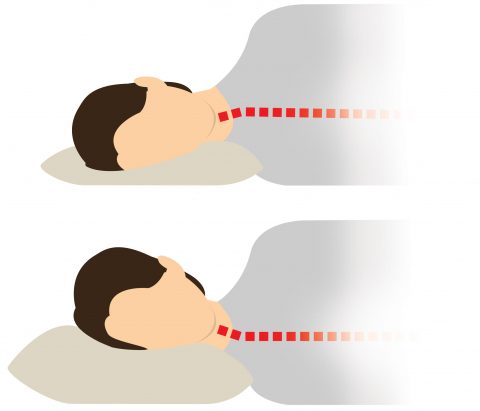
If your pillow doesn’t keep your head at the correct level, it is likely you will experience back and neck pain.
Consistent pain in the neck? Let’s dive a bit deeper and look at some long-term solutions…
Remember, these are just temporary fixes! If you had a bad night, try all of the above and hopefully you’ll get some relief.
However, if you’re experiencing neck pain from sleeping on a consistent basis, do something that addresses the root of the issue(s) rather than just treating the symptoms.
Experts suggest modifying your sleep environment.
It’s not just about having a bed that feels like a cloud. Your mattress should have your back (literally), supporting you just right so your spine stays straight and happy all night long. And your pillow? That’s your neck’s best buddy. You want something that keeps your neck in line, like it’s doing a perfect yoga pose while you snooze. There’s a world of pillows and mattresses out there – and no single type is right for everyone. Make sure you try several until you find one that works. Many companies (ours included) have generous return policies that allow you to test drive them in your own home.
Try a new pillow first.
The wrong pillow can exacerbate or even be the cause of your neck pain. Often the solution is simple: replace your pillow with a more suitable one. A good pillow will keep your spine from bending unnaturally upwards or downwards and provide comfortable, even support for your entire head and neck. An ill-suited mattress can also cause neck pain, although that is less commonly the culprit. A new mattress is also an expensive solution, so try some different pillow options first!

Beautiful buckwheat hulls: Hullo Pillow’s contents are revealed.
Have you ever tried a buckwheat pillow?
Before I discovered buckwheat pillows, my mornings were a literal pain in the neck. I tried everything—memory foam, down, synthetic—you name it, all to no avail. Then, a friend mentioned he’d switched to a buckwheat pillow and was sleeping like a baby, neck pain-free. Skeptical but desperate, I decided to give it a shot.
The first night was a bit of an adjustment; the rustling sound of buckwheat hulls and the firmness were new to me. However, I woke up the next morning without the usual stiffness in my neck. It felt like a small miracle. Days turned into weeks, and my neck pain, a faithful companion for so long, simply vanished.
The more I used it, the more I loved it. Not only did it alleviate my neck pain, but it also stayed cool throughout the night and easily adapted to my preferred sleeping position. It’s been a game-changer for my sleep quality and my life. I’ve never looked back since that switch.
In fact, I like these unique pillows so much that I decided to manufacture and sell them. Don’t take my word for it! Our customer’s reviews speak for themselves.
“For a few years, I have been searching for a pillow that allows me to wake up without neck pain. I have literally spent nearly $1,000 on pillows. Soft, firm, memory foam, contour, gel, designed by sleep specialists, etc… I have tried them all with no relief. I got my Hullo pillow yesterday and this morning is the first morning in years I have awoken with no neck pain. Love my Hullo!” -Valerie, verified Hullo customer
Sleep on Hullo buckwheat pillow for 60 nights. If it doesn’t work for you, just ship it back to us and we’ll refund the purchase price.
Additional Sources: Effects of Acute and Chronic Stretching on Pain Control
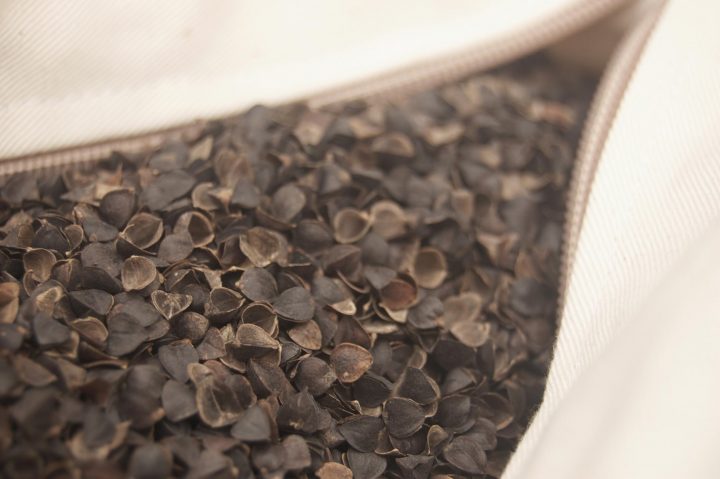 My family attempts to live a healthy and responsible lifestyle. We eat healthy, nourishing food and we all spend time outdoors together for fresh air and exercise. In addition, we try to make choices that are ecologically responsible. Our children deserve a world that isn’t damaged by our generation’s irresponsibility. As any parent will attest, it is very important to feel like you’ve provided the best environment possible for your child.
My family attempts to live a healthy and responsible lifestyle. We eat healthy, nourishing food and we all spend time outdoors together for fresh air and exercise. In addition, we try to make choices that are ecologically responsible. Our children deserve a world that isn’t damaged by our generation’s irresponsibility. As any parent will attest, it is very important to feel like you’ve provided the best environment possible for your child.
We try to make this a habit both for our own and future generations’ sake.
Because of this, my wife and I scrutinize every product we use. BPA-free plastic, organic, all-natural, non-toxic – whatever the lingo may be – if we determine that it’s safer than the alternatives and not outrageously priced-we go with it. It’s not always easy to know what the “right” choice is, but generally with a little research into the product at hand, the answer is often quickly found. Unfortunately, sometimes the more research you do, the scarier things get. I discovered this a few years ago when it came time to move my daughter into her own room.
I began to investigate bedding and was shocked to find that pillows, mattresses and other products often contain dangerous toxic chemicals.
Formaldehyde is one of the nastier ones: The World Health Organization identifies it as a carcinogen. Inhalation has been linked to a host of cancers, including nasopharyngeal cancers, leukemia, and lymphoma. Childhood cancer is on the rise due to the prevalence of formaldehyde and similar chemicals in so many of the products we use. In addition, due to government regulations on fire retardancy, bedding products are often treated with hazardous materials that are now linked with serious health issues. These regulations are currently being debated and investigated for perhaps being counter-productive.
Natural Pillows vs. Synthetic Pillows: What’s the Difference?
Popular pillows with fill containing polyurethane or polyester foam can emit the toxins and carcinogens that were used in the manufacturing process. Short-term side effects for those sensitive to these emissions can include headaches, sinus issues and eye irritation. Long term-side effects are mostly unknown but could potentially include some cancer types.
In addition to hazardous fill, the pillow’s fabric case can be host to all kinds of dangerous materials.
Cotton, the most frequently used bedding fiber, is unfortunately grown using some of the world’s most hazardous pesticides.
“Conventionally grown cotton uses more insecticides than any other single crop and epitomizes the worst effects of chemically dependent agriculture… Cotton growers typically use many of the most hazardous pesticides on the market including aldicarb, phorate, methamidophos and endosulfan… Pesticides used on cotton– even when used according to instructions– harm people, wildlife and the environment.”
After it is harvested, it is often bleached, treated and dyed. These procedures inevitably leave behind a multitude of chemicals in the fibers. Bleach is considered one of the most toxic substances in the home. Bleach can contribute to cancer, endocrine disorders and other health problems. Dioxins contained in bleach have the ability to mimic human hormones and can cause low sperm count, testicular cancer or breast cancer. We know now that chemicals like formaldehyde and bleach are carcinogens, but others’ negative effects have yet to be discovered.
This wall of information is intimidating and confusing. Also, it just isn’t practical for most families to completely isolate themselves from the products manufactured as described above. Let me make a simple recommendation: limit exposure to these materials when it’s cost effective. We spend 1/3 of our lives on a pillow; it’s pretty hard to avoid a lot of exposure to its constituent materials. Thus, this is a product worth investigating carefully and perhaps spending a bit more on. Spend your hard-earned cash proportionally based upon exposure/use.
Be Comfortable and Safe – Choose Natural Pillows
My advice is to look for all-natural pillows containing fill like goose down, millet, kapok or buckwheat hulls. The pillow’s shell (containing the fill) should be made from unbleached organic cotton or similar chemical-free fiber. Obviously I’m partial to our own Hullo!
 After purchasing a small buckwheat pillow and falling in love with it, I set out to make my own standard sized (20×26″) buckwheat pillow. This pillow ultimately became the first Hullo buckwheat pillow prototype. I quickly found high-quality fabrics and tons of different tough-looking zippers, but locating bulk buckwheat hulls proved to be very time consuming.
After purchasing a small buckwheat pillow and falling in love with it, I set out to make my own standard sized (20×26″) buckwheat pillow. This pillow ultimately became the first Hullo buckwheat pillow prototype. I quickly found high-quality fabrics and tons of different tough-looking zippers, but locating bulk buckwheat hulls proved to be very time consuming.
Buckwheat hulls are available in many different varieties and qualities. My goal was simple: find the best ones for use in a pillow.
Firstly, I narrowed the search considerably by considering only USA produced buckwheat hulls. Our company, Hulltex, is American, based in Duluth, Minnesota. It’s very important to us that we support locally owned farms and companies, particularly during these challenging economic times.
Imported Bulk Buckwheat Hulls
China, Russia, Kazakhstan, Ukraine and and several other eastern european countries are big exporters of buckwheat. There are certainly good prices to be found, but they are typically not produced using the same high standards practiced in the USA.
Imported hulls come to North America via the oceans. The ocean shipping industry has unfortunately caused a substantial amount to climate change. More than 3% of global carbon dioxide emissions are a result of ocean shipping.
Manufacturers of buckwheat pillows that utilize imported buckwheat hulls will sometimes market their hulls as having been “roasted.” This term refers to a process required by the US government to remove any potential contaminants the product might contain prior to being distributed to American markets; it prevents the spread of plant pests and diseases. The hulls are subjected to high heat. This process unfortunately eliminates some moisture content, making the hulls a bit more brittle, dusty and prone to flattening out.
Bulk Buckwheat Hulls – Sample #1
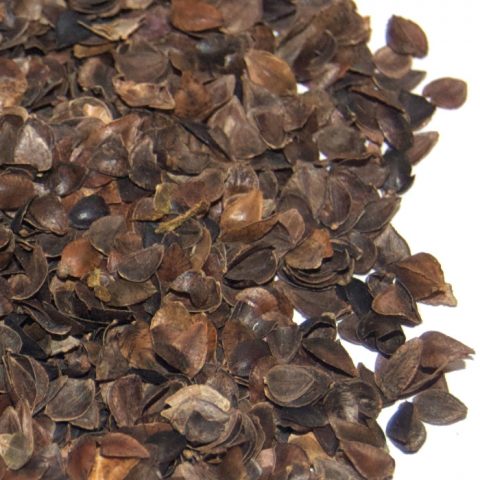
These certified organic buckwheat hulls have been crushed flat, making them less effective for use in a pillow.
I ordered our first sample buckwheat hulls thinking that they’d be perfect. They were certified organic and a good price! When they arrived in the mail, they weren’t quite what I’d hoped. The hulls weren’t intact and were crushed into small pieces.
So what’s wrong with crushed hulls? (A few minor things if you’re a pillow nerd):
- Using this type of hull will result in a pillow that doesn’t hold its shape as well as it could. The flattened hulls have lost much of their rough edges; they do not grip one another as well as intact ones do.
- There’s much less space between the buckwheat hulls when they’ve been crushed flat. The benefit of air circulation (and a cool pillow) is diminished.
- When crushed, buckwheat hulls, especially if they’re very dry, will break into very small pieces, creating dust. Even with vacuum-cleaning, dust can remain with the larger pieces of buckwheat hulls. These small pieces can work their way through a thin pillowcase and make a mess.
- Buckwheat hull pillows are not light. Flattened hulls are more dense than intact ones and will increase the weight your already hefty pillow.
Some marketers of buckwheat pillows use this characteristic to their advantage claiming that they’ve been “pre-flattened” or “polished.”
It’s our belief that intact hulls are superior, but there are two distinct, albeit small, advantages to crushed buckwheat hulls:
- They will make less noise when the pillow is moved.
- They will retain their volume longer. Thus, your pillow’s loft will be more consistent over time. Flattened hulls are already lacking their natural loft, so you can adjust your pillow’s thickness once and it won’t change much with use.
Bulk Buckwheat Hulls – Sample #2
My second sample of buckwheat hulls wasn’t much more successful than the first. Another certified organic variety with a much higher price tag arrived at my door step. I tore into the package and was disappointed to see the tiny little hulls contained. While completely intact, the individual hulls were tiny compared to some of the larger varieties available. Being so small, these were quite dense; they were heavier and restricted air flow much like the crushed buckwheat hulls in my first sample.
Finding the Best Bulk Buckwheat Hulls
I got a several other samples with similar issues — they were all less than ideal for one reason or another. Finally a sample came that was perfect… well almost. The buckwheat hulls were:
- completely intact,
- large enough to allow good air circulation, and
- mostly dust free.
Do Organic Buckwheat Hulls Matter?
The one catch was that they weren’t certified organic. Does that matter? After pouring through available data, we determined that it was of little importance that the buckwheat hulls be certified. Buckwheat grows very well without requiring noxious fertilizers or pesticides that are commonly used for other crops. Thus, it is most often very close to the definition of organic without actually being certified organic.
In the end, it wasn’t a difficult decision. I decided that it was better to use buckwheat hulls with superior physical characteristics rather than rely on the insignificant label applied to potentially inferior pillow fill… even if they costed more!
In summary, without seeing the buckwheat hulls up close in person, it’s very difficult to know what you’re getting. We’ve done that for you. If you’re in the market for buckwheat hulls for use in a pillow, look no farther. We’ve selected the best we could find and use them in every Hullo™ we ship. We guarantee you’ll agree. If you’re unhappy for whatever reason, just ship them back to us and we’ll refund you the purchase price.

Can a buckwheat pillow be washed? Yes.
Buckwheat pillows can last can last many years with proper care. The first and most important thing you can do to keep your buckwheat pillow in good shape is keep it protected inside a standard pillowcase just like any other type of pillow. This will allow you to wash just the pillowcase intermittently, so that the pillow itself doesn’t need cleaning so frequently.
Eventually all pillows get stained, sullied, soiled or even sometimes stinky 🙁
When your buckwheat pillow’s better days seem to have passed, refresh it with a wash:
- Remove the buckwheat hulls by pouring them into a larger container. A large paper grocery bag works better than plastic as it will hold its shape, making pouring much easier.
- Turn the fabric case inside-out and make sure to remove all of the buckwheat hulls out of the nooks and crannies so that they don’t get into your washing machine. Careful not to spill!
- Toss the case into the washing machine. Don’t forget, cotton can shrink! To avoid shrinkage and wear, wash it in cold water (75 to 85 degrees Fahrenheit) and keep it out of the dryer (air dry).
- Replace the buckwheat hulls. ProTip: ask a friend to pour while you hold the fabric case.
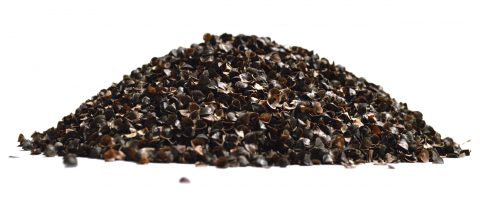
Buckwheat hulls can be refreshed or simply replaced.
What about cleaning the buckwheat hull fill?
Keep the outside of your pillow laundered occasionally and you will not need to worry about the buckwheat hulls inside. Accidents do happen though. If you’ve soiled your buckwheat hulls somehow, you can try letting them sit indoors under gently circulating air, preferably in sunlight, to remove any moisture or odors. Spread them out evenly on smooth flat surface.
*Note* If you’ve spilled water on your pillow remove the wet hulls immediately. As long as you dry them quickly, they’ll be good as new. A beer or soda spill is can be more trouble than it’s worth. For these situations we recommend replacement buckwheat hulls.
Buckwheat hulls will slowly break down or flatten out over time with use.
You might notice when you open your pillow to clean it that the buckwheat hulls look a little different. Buckwheat hulls will slowly break down into smaller pieces over time. Clean or not, they should be replaced periodically. It generally is a matter of years before you’ll notice any real degradation, but flattened hulls can cause a couple (small) problems:
- The buckwheat hulls have lost some of their loft. Your pillow may feel flatter and not provide the support it once did.
- The buckwheat hulls have lost some of their malleable character. Your pillow won’t hold its shape as well as it could. The flattened hulls have lost much of their rough edges; they do not grip one another as well as intact ones do. They also have less “give” or softness.
- There’s less space between the buckwheat hulls when they’ve been crushed flat. The benefit of air circulation (and a cool pillow) is diminished.
If your pillow feels a little flatter than it used to, it might be worth replacing them to restore some of the pillow’s original quality. We sell the best pillow-grade buckwheat hulls in 10 and 20 lb. quantities. This handy buckwheat filling calculator will help you determine how much filling you need.
If you follow these simple steps for how to clean buckwheat pillows, you should enjoy many years of good sleep with it.
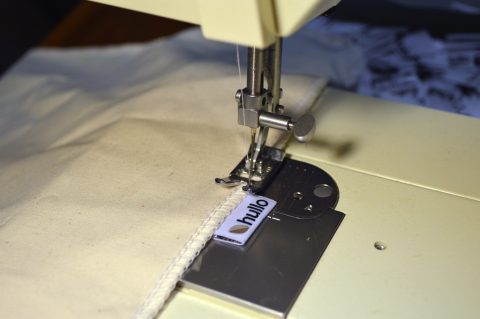
Hullo Pillows are cut & sewn in the U.S.A.
When we set out on our mission to make the best buckwheat pillow we knew that we wanted to support American farmers and businesses. We looked far and wide for the best materials and manufacturers. There are many cheap options available oversea but we knew that the highest quality materials and the best craftsmanship were available right here in the USA.
Hullo pillows are cut, sewn and assembled in the U.S.A.
- Buckwheat Hulls: Pillow-grade buckwheat hulls are grown, milled and air-cleaned in North Dakota.
- Zipper: High-quality Dunlap zippers are manufactured in Tennessee.
- Labels: Labels are woven and printed in New York and Colorado.
- Pillow Case: The organic cotton outer fabric shell containing Hullo’s buckwheat fill is cut and sewn in Minnesota.
- Website: Designed & Developed by a team of American designer/developers.
Better Products, Better Sleep: Hullo pillows are cut, sewn and filled in the USA.
We take our pillows very seriously. For us, it was easy to spend a little extra for the quality that only American farmers, companies and craftsmen can offer. Take a close look at pillows manufactured overseas, and it’s clear that low-cost, high-volume manufacturing in China, India, and other emerging economies does not compare to the design, durability and detail that comes with not just American pillows, but all American-made products.
By purchasing our Hullo buckwheat pillow and other well-crafted Amerian products, you are supporting small business in America. Thank you!

When comparing buckwheat pillows there are a number of things to consider. Not all pillows are created equal and there are a few details which can make a big difference in the product that you choose. Make an informed choice when choosing your buckwheat pillow by keeping these things in mind:
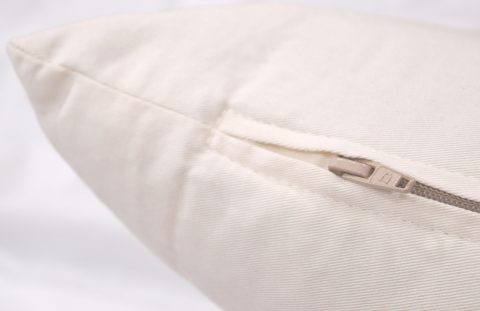
This high quality Dunlap auto-locking zipper slides back into a pocket that prevents the pillow from losing any of its precious filling.
Zipper & Adjustability
Does the pillow have a zipper? A zipper is an important feature on a buckwheat pillow for a few reasons. First, it allows you to add or remove fill to adjust the pillow’s thickness to suit your personal preference. Second, a zipper allows you to remove the fill so you can wash the pillow case, keeping your pillow fresh and clean. Third, if you ever want to refresh pillow with new, springy hulls or if you’d like add aromatherapy scents to your pillow, a zipper gives you all the flexibility you need.
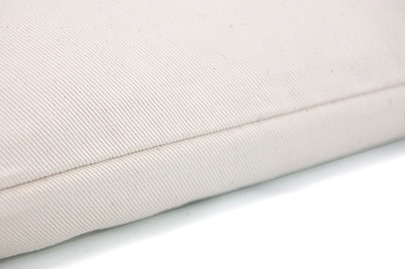
Certified Organic Cotton Twill
Made with Quality Materials
What kind of material is the pillow made of? How is it designed and constructed? What kind of buckwheat hulls is it filled with? The shell of Hullo is 100% certified organic cotton. Our top-quality hulls are grown and milled in the U.S.A. by American farmers. Our heavy duty zipper is made by Dunlap.
Includes Free Shipping
Buckwheat pillows are relatively heavy and bulky objects. The cost of shipping is an important factor to keep in mind when shopping for a buckwheat pillow. We ship every order for free to addresses in the contiguous United States.
Designed and Manufactured in U.S.A.
Was the case cut & sewn in the United States? Where was the buckwheat grown and milled? Make sure you are supporting American workers when you choose your pillow.
Customer Service
Is the pillow in stock and ready to ship? What is the shipping method and how long will it take to get your pillow? If you aren’t satisfied, can you return the pillow? It’s always a good idea to purchase a product that is guaranteed. Every Hullo is covered by a money-back guarantee, and we’re always available to address your questions or concerns about Hullo.
Thanks for considering Hullo, and whatever pillow you use we hope you sleep well tonight.

